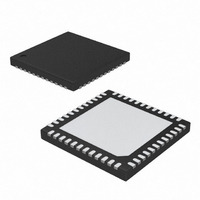MAX9853ETM+ Maxim Integrated Products, MAX9853ETM+ Datasheet - Page 29

MAX9853ETM+
Manufacturer Part Number
MAX9853ETM+
Description
IC CODEC AUDIO STEREO 48TQFN
Manufacturer
Maxim Integrated Products
Type
Stereo Audior
Datasheet
1.MAX9851ETM.pdf
(71 pages)
Specifications of MAX9853ETM+
Data Interface
Serial
Resolution (bits)
18 b
Number Of Adcs / Dacs
2 / 2
Sigma Delta
Yes
S/n Ratio, Adcs / Dacs (db) Typ
81.5 / 88
Dynamic Range, Adcs / Dacs (db) Typ
82 / 87.5
Voltage - Supply, Analog
2.6 V ~ 3.3 V
Voltage - Supply, Digital
1.7 V ~ 3.3 V
Operating Temperature
-40°C ~ 85°C
Mounting Type
Surface Mount
Package / Case
48-TQFN Exposed Pad
Conversion Rate
48 KHz
Resolution
18 bit
Operating Supply Voltage
1.7 V to 3.3 V
Maximum Operating Temperature
+ 85 C
Mounting Style
SMD/SMT
Minimum Operating Temperature
- 40 C
Snr
75 dB
Lead Free Status / RoHS Status
Lead free / RoHS Compliant
The MAX9851 CODEC, with a stereo DirectDrive head-
phone amplifier and a stereo Class D speaker amplifi-
er, is a complete digital audio solution for GSM/
GPRS/EDGE cell phones and PDA phones. The
MAX9853 audio CODEC shares all the functionality of
the MAX9851 without the Class D speaker amplifier,
substituting it with stereo differential line outputs to
facilitate external amplifiers and other analog audio
devices. The MAX9851/MAX9853 additionally feature
stereo and mono microphone inputs, and a mono
DirectDrive handset receiver amplifier combined with
sigma-delta stereo DACs and stereo ADCs.
The sigma-delta DAC has 88dB of dynamic range and
accepts stereo audio data from two independent digital
audio interfaces at sampling frequencies ranging from
8kHz to 48kHz. The interfaces can accept I
ble data in addition to voiceband data and allows the
mixing of multiple audio sources at different unrelated
sample rates. The primary digital audio input integrates
bandpass filtering that can be used when operating in
voice mode. Digital audio from the ADC can output on
both interfaces allowing maximum flexibility.
Analog and digital volume levels, muting, and device
configuration are programmed through the I
ible interface. Audio data is sent to and from the
MAX9851/MAX9853 through either of two 4-wire digital
audio data buses that support numerous formats.
LRCLK and BCLK signals are generated by the
MAX9851/MAX9853 when configured in master mode.
The MAX9851/MAX9853 can also be configured as a
slave DAC stereo audio playback device or a full
duplex slave voice CODEC, accepting LRCLK and
BCLK signals from an external digital audio master.
Maxim’s DirectDrive architecture employs an internal
charge pump to create a negative voltage supply pow-
ering the headphone and receiver amplifier outputs.
The internal negative supply allows the analog output
signals to be biased at ground, eliminating the need for
an output-coupling capacitor, reducing system cost
and size. The MAX9851/MAX9853’s stereo line inputs
allow mixing of analog audio with digital audio.
Numerous signal routing options and programmable
gain allow any combination of analog and digital input
signals at varying signal levels to be routed to any out-
put. Sophisticated headset sensing circuitry allows the
Stereo Audio CODECs with Microphone, DirectDrive
Headphones, Speaker Amplifiers, or Line Outputs
______________________________________________________________________________________
Detailed Description
2
2
S-compati-
C-compat-
MAX9851/MAX9853 to detect a wide variety of headset
configurations and trigger a hardware interrupt on jack
insertion (even when powered down). The external
stereo microphone inputs provide configurable internal
bias resistors and a gain range of 40dB to accommo-
date a wide variety of microphones. The internal mono
microphone input provides a differential input and a
gain range of 40dB. The VIBE digital output can be
used to control a vibrator, transducer, or can be used
as a general-purpose digital output.
The MAX9851/MAX9853 have two independent digital
audio interfaces, S1 and S2, each capable of operating
independently in the full-duplex master and slave tim-
ing modes shown in Figures 1 and 2. The second digi-
tal audio interface operates from a secondary supply
voltage (DV
ple supply systems.
Set S1SDO or S2SDO to 1 (register 0x03 or 0x05, bit
B7) to enable the output of ADC data to the corre-
sponding SDOUT pin. Enabling both SDOUTS1 and
SDOUTS2 will output the same digital audio signal on
both interfaces and the primary S1 interface will specify
the sample rate of the ADC.
Set S1SDI or S2SDI to 1 (register 0x03 or 0x05, bit B6)
to enable DAC input and begin an internal soft-start
sequence for the corresponding SDIN pin. Clearing a
particular SDI bit begins an internal soft-stop sequence
prior to disabling the input. The SLD slew detect status
bit (register 0x00, bit B6) indicates when a soft-
start/stop sequence has completed. This allows inter-
face mode changes without interrupting the other
interface’s signal flow. Clear both S1SDI and S2SDI
before enabling the left and right DAC with DACLEN
and DACREN (register 0x1B, bits B7 and B6).
To achieve the most exact sample clocks, operate the
MAX9851/MAX9853 in slave mode with the exact
LRCLK provided externally (in DAC-only mode) or in
master mode with the ADCs disabled. The ADC
requires an exact integer LRCLK frequency resulting in
less accurate sample clocks than when only operating
the DAC. Slave mode is only available for the DACs
when the ADCs are inactive, or for fully synchronous
8kHz and 16kHz voice modes.
Table 1 lists the MAX9851/MAX9853 available interface
modes for each sampling frequency.
DDS2
) to allow simple integration into multi-
Serial Digital Audio Interface
29











